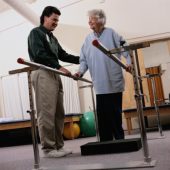
TUESDAY, Nov. 24 (HealthDay News) — Falls are a leading cause of death among older Americans, and new research confirms that chronic pain contributes to those accidents.
“Pain contributes to functional decline and muscle weakness, and is associated with mobility limitations that could predispose to fall,” the study authors wrote.
“Chronic pain, no matter how we measured it, was associated with an increased likelihood of falls,” said lead researcher Suzanne G. Leveille, from Beth Israel Deaconess Medical Center in Boston and the University of Massachusetts. “Pain has not traditionally been thought of as a risk factor for falls.”
Health-care costs associated with falls account for more than $19 billion each year, but the role pain plays in those falls was not explored before, the authors said.
Based on these findings, Leveille thinks that pain should be a factor in assessing the risk for falls. She also said effective pain management might reduce the risk of falls.
Patients should discuss pain and falling with their doctor and work out a plan to prevent falling, she added.
For the study, published in the Nov. 25 issue of the Journal of the American Medical Association, Leveille’s team asked 749 people, aged 70 and older, about any pain they suffered. The participants also kept a record of each time they fell.
At the start of the study, 40 percent of the participants said they suffered from chronic pain in more than one joint, and 24 percent had pain in only one joint.
During 18 months of follow-up, there were 1,029 falls. More than half (55 percent) reported falling at least once.
Those people who had pain in more than one joint were more likely to fall, compared with people who reported no pain or minimum pain. Severe pain and pain that affected participants’ ability to do daily activities also made falls more likely, the researchers found.
In addition, having pain in one month made falling in the next month likely. People who reported severe pain in one month had a 77 percent increased risk of falling the next month. Even people reporting very mild pain were more likely to fall the following month, the group found.
The authors noted that the neuromuscular effects of pain could cause leg muscle weakness or slow neuromuscular responses to a loss of balance. Attempts to ease pain by changing gait may also cause balance problems, and chronic pain may be a huge distraction, making people less aware of hazards, according to the report.
Pain tends to be thought of as part of growing old, Leveille said. “People tend to be dismissive of it, but this study shows that it may not be such a minor thing. There could be some very serious hazards related to chronic pain,” she noted.
Colin Milner, chief executive officer of the International Council on Active Aging, welcomed the findings. “This study shows us the importance of recognizing that pain typically has a cost associated with it, as it may be a symptom of a greater issue that, in this case, if left unattended can have serious consequences.”
Health professionals, fitness and wellness professionals now have another tool in creating fall reduction programs, Milner said. “Now, if they have not before, they may have a better understanding of how pain impacts many systems in the body and how these can impact falls,” he said.
“If we look at the population as a whole, the number of people with pain is significant,” Milner added. “This study shows that addressing this pain early is not only preventative in nature, but cost-effective, as the long-term costs associated with falls is significant.”
More information
For more information on falls, visit the U.S. National Library of Medicine.</p

